Why Photo Scanning Still Matters Today
In a world flooded with smartphone snapshots, many of our most meaningful memories are still sitting in shoeboxes, albums, or drawers—fading. Whether it’s a wedding photo, a baby’s first smile, or a handwritten caption from the ‘80s, these moments deserve to be seen, not stored away.
That’s where a photo digitizing service comes in. It’s not just about saving space. It’s about giving your old photos a second life—cleaned up, backed up, and ready to be shared with the people who matter.
How to Scan Pictures the Right Way
You could try scanning one photo at a time on a home printer. But as many families discover, it’s slow, inconsistent, and sometimes damaging to fragile originals. Here’s what to consider when digitizing:
-
Resolution matters: Photos should be scanned at a minimum of 300 DPI (dots per inch). For professional results, go for 600 DPI.
-
Flatbed vs. feed scanner: Feed scanners are fast but can bend or scratch photos. Flatbeds offer better quality and safety.
-
Color correction: Faded images often need restoration. A good photo scanning service will automatically adjust for tone, contrast, and clarity.
-
File format: JPEG is the most common, but for archival purposes, learn more about what’s a JPG and when to use higher-resolution formats like TIFF or PNG.
If this sounds overwhelming, there’s no shame in asking for help. Many people choose a professional digitizing team because of the care and consistency it provides.

What a Professional Photo Digitizing Service Includes
Not all services are equal. A high-quality provider doesn’t just scan your pictures—it curates your history with accuracy and respect. Here's what sets the best apart:
-
Organized digital folders by event or year
-
Gentle handling of delicate prints
-
Clear communication and tracking
-
Optional cloud-based photo scanning with easy sharing across devices and generations
Some services still return your memories on DVDs or USBs—but those can degrade too. That’s why companies like Heirloom now offer America’s most convenient photo scanning service with private, secure cloud storage instead.

Common Questions About Photo Scanning
Do I need to remove photos from albums?
Not always. Many services can scan photos directly from traditional albums, especially 4x6 slots or archival pages.
Can I include notes or labels?
Yes! Captions, sticky notes, and written dates can all be digitized alongside your images, preserving context as well as content.
Will I get my originals back?
You should. Any reputable service will return your photos in the same condition, often with better organization than before.

📧 Want more tips like this?
Subscribe to Heirloom emails to learn how to preserve your priceless memories. Get discount codes for expedited shipping, quality digitizing, and secure cloud storage. We never spam, and it’s easy to unsubscribe at any time.



